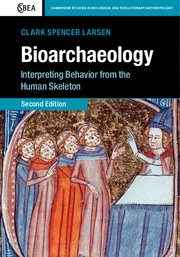Book contents
- Frontmatter
- Dedication
- Contents
- Preface to the Second Edition
- Preface to the First Edition
- 1 Introduction
- 2 Stress and deprivation during growth and development and adulthood
- 3 Exposure to infectious pathogens
- 4 Injury and violence
- 5 Activity patterns: 1. Articular degenerative conditions and musculoskeletal modifications
- 6 Activity patterns: 2. Structural adaptation
- 7 Masticatory and nonmasticatory functions: craniofacial adaptation to mechanical loading
- 8 Isotopic and elemental signatures of diet, nutrition, and life history
- 9 Biological distance and historical dimensions of skeletal variation
- 10 Bioarchaeological paleodemography: interpreting age-at-death structures
- 11 Bioarchaeology: skeletons in context
- References
- Index
- Plate section
6 - Activity patterns: 2. Structural adaptation
Published online by Cambridge University Press: 05 April 2015
- Frontmatter
- Dedication
- Contents
- Preface to the Second Edition
- Preface to the First Edition
- 1 Introduction
- 2 Stress and deprivation during growth and development and adulthood
- 3 Exposure to infectious pathogens
- 4 Injury and violence
- 5 Activity patterns: 1. Articular degenerative conditions and musculoskeletal modifications
- 6 Activity patterns: 2. Structural adaptation
- 7 Masticatory and nonmasticatory functions: craniofacial adaptation to mechanical loading
- 8 Isotopic and elemental signatures of diet, nutrition, and life history
- 9 Biological distance and historical dimensions of skeletal variation
- 10 Bioarchaeological paleodemography: interpreting age-at-death structures
- 11 Bioarchaeology: skeletons in context
- References
- Index
- Plate section
Summary
Bone form, function, and behavioral inference
Julius Wolff, a leading nineteenth-century German anatomist and orthopedic surgeon, recognized the remarkable sensitivity of skeletal tissues to mechanical stimuli, especially with regard to their ability to adjust size and shape in response to external forces. Wolff concluded that “every particle of mature bone is very active. Such activity must appear in the external shape of the bones” (1892:78). What he called the “law of bone remodeling” – now commonly known as Wolff’s Law – simply states that bone tissue places itself in the direction of functional demand. Wolff’s Law in the twenty-first century has a somewhat different meaning than what Julius Wolff intended, and is best referred to as “bone functional adaptation” (Ruff et al., 2006).
A great deal of evidence has accrued in support of the notion that bone adapts to and is shaped by its mechanical environment. Experimental and other research on bone modeling and remodeling is instrumental in identifying patterns of skeletal modification under different loading regimes, especially with respect to the magnitude and direction of mechanical forces (Bass et al., 2002; Lanyon et al., 1982; Meade, 1989; Ruff, 2008; Trinkaus et al., 1994). In a set of classic experiments using laboratory dogs, Chamay and Tschantz (1972) observed that the surgical removal of portions of radii resulted in the hypertrophy of ulnar diaphyses. The ulnar diaphyses increased in size by 31% after just 16 days and 60%–100% by nine weeks. Similarly, Lanyon and coworkers (Goodship et al., 1979; Lanyon & Bourne, 1979) documented increased apposition of bone on the radius following ulnar osteotomies in pigs and sheep. Nonsurgical load alterations have also resulted in changes in bone mass. Woo and coworkers (1981) identified significant endosteal apposition in young pigs subjected to exercise. Simkin and coworkers (1989) compared humeri from swimming and non-swimming rats in an experimental setting. The swimming rats included a group trained to swim for one hour per day and a group that underwent the same training, but also had a lead weight (approximately 1% of the rat’s body weight) tied to their tails. Comparison of bone size and structure revealed that both groups of swimming rats had greater periosteal apposition than the sedentary, non-swimming rats.
- Type
- Chapter
- Information
- BioarchaeologyInterpreting Behavior from the Human Skeleton, pp. 214 - 255Publisher: Cambridge University PressPrint publication year: 2015

